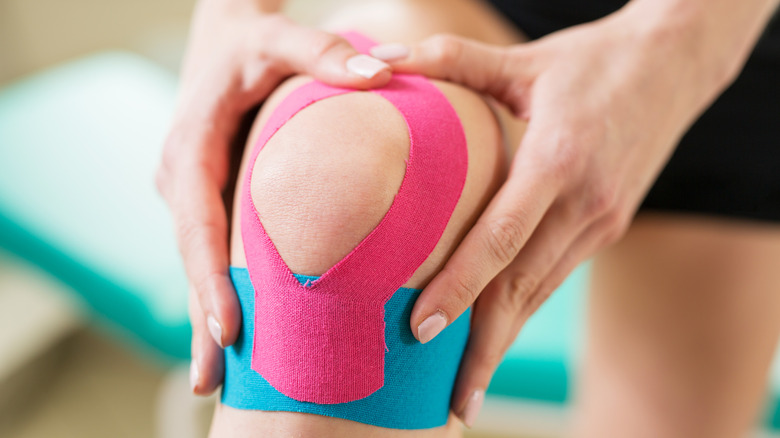How Does Kinesiology Tape Work?
If you've watched marathon runners in action or an NBA game recently, you've probably noticed strips of brightly colored tape on some of the athletes. Kinesiology Therapeutic (KT) tape has grown in popularity in recent decades since it was invented by a Japanese chiropractor in the 1970s. It is used by athletes to support worn or injured tissues and joints (via Healthline). Unlike regular athletic tape, which restricts movement and doesn't allow for a full range of motion, KT tape is made from a blend of cotton and nylon fibers. They are specially designed to mimic skin elasticity and allow for one-directional stretching, offering support while still allowing for normal movement.
"Kinesiology tape is a type of elastic tape that is applied to an area of musculoskeletal dysfunction," Dr. Cameron Yuen, a doctor of physical therapy at Bespoke Treatments in New York City, told Well+Good. "Think strains, sprains, or swollen joints. This tape encourages movement and awareness, as opposed to athletic tape, which is used to brace and prevent movement."
KT tape is often used in combination with other therapies
Although studies have produced some mixed results, KT tape is thought to work by gently lifting the skin from the tissues underneath it. This is thought to provide more space between the tissues in the injured area for lymphatic fluid to flow, rather than allowing it to accumulate and cause increased pressure and pain (via Gurnee Podiatry and Sports Medicine). The theory is that this increased flow promotes faster healing, along with less swelling and pain.
KT tape is also used, even in the absence of injury, to provide extra support to weak or worn areas. It is thought to help retrain muscles that have stopped being fully functional and even correct posture. Therapists speculate that rather than the tape itself, it could be the individual's increased awareness of movement and posture that makes the difference (via Healthline).
Usually, KT tape is used in combination with other therapies, like massages or stretches. While it can be helpful, it's not designed to be used long-term. "Taping is not a permanent solution," Dr. Megann Schooley, board-certified clinical specialist in sports physical therapy and certified strength and conditioning specialist, told Healthline. "You want to build your strength and skill, because correcting the root problem is key."


